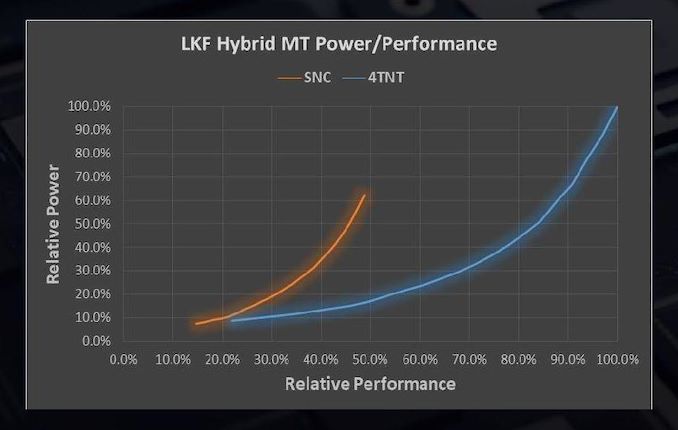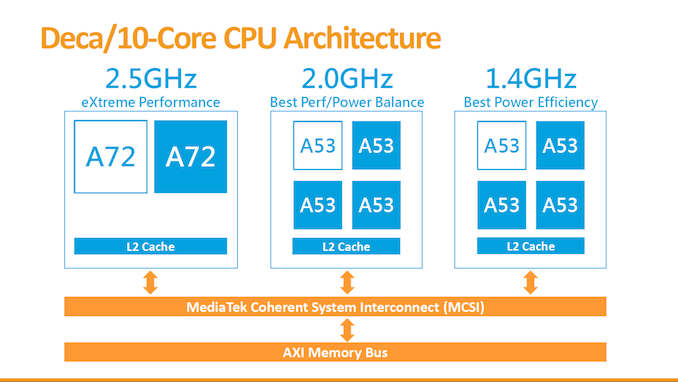The Intel Lakefield Deep Dive: Everything To Know About the First x86 Hybrid CPU
by Dr. Ian Cutress on July 2, 2020 9:00 AM ESTHow To Treat a 1+4 Hybrid CPU
At the top of the article, I explained that the reason for using two different types of processor core, one big on performance and the other big on efficiency, was that users could get the best of both worlds depending on if a workload could be run efficiently in the background, or needed the high performance for a user experience interaction. You may have caught onto the fact that I also stated that because Intel is using a 1+4 design, it actually makes more sense for multi-threaded workloads to run on the four Atom cores.
Using a similar power/performance graphs, the effect of having a 1+4 design is quite substantial. On the left is the single core power/performance graphs, but on the right is when we compare 1 Sunny Cove to all 4 Tremont cores working together.
Where the previous graph considered a 1+1 design, which is more relevant in those user experience scenarios listed above, on the right is the 1+4 design for when the user demands a heavier workload that might not be latency critical. Because there are four Atom cores, the blue line multiplies by four in both directions.
Now obviously the real world scenario is somewhere between the two, as it is possible to use only one, two, or three of the smaller cores at any given time. The CPU and the OS is expected to know this, so it can govern when workloads that can be split across multiple cores end up on either the big core or the small core.
In this graph from Intel, we have three distinct modes on which threads can operate.
- ‘Sunny Cove/SNC’ is for responsiveness and user experience threads,
- ‘Tremont/TNT Foreground’, for user related tasks that require multiple threads that the user is waiting on.
- ‘Tremont/TNT Background’, for non-user related tasks run in efficiency mode
Even though the example here is web browsing, it might be best to consider something a bit beefier, like video encoding.
If we run video encoding, because it is a user related task that requires multiple threads, it will run on the four Tremont cores (TNT FG). Anything that Windows wants to do alongside that gets scheduled as TNT BG. If we then open up the start menu, because that is a responsiveness task, that gets scheduled on the SNC core.
Is 1+4 the Correct Configuration?
Intel here has implemented a 1+4 core design, however in the smartphone space, things are seen a little differently. The most popular configuration, by far, is a 4+4 design, simply because a lot of smartphone code is written to take advantage of multiple foreground or multiple background threads. There are a number of cost-down designs that reduce die area and power by going for a 2+4 implementation. Everyone seems adamant that 4 is a good number for the smaller cores, partly because they are small and cheap to add, but because Arm’s quad-core implementation is a base unit for its IP.
The smartphone space in recent quarters has also evolved from a two tier system of cores. In some of the more leading edge designs, we now have three types of core: a big, a middle, and a small. Because of the tendency to stay with eight core designs, we now get 1+3+4 or 2+2+4 designs, powered by complex schedulers that manage where to put the threads for the best user experience, the best battery life, or somewhere in the middle. Mediatek has been famously dabbling in 10 core designs, going for a 2+4+4 approach.
One thing missing from all of these implementations is an SoC with one big core and four small cores. Smartphone vendors don’t seem to be interested in 1+4 silicon, and yet Intel has decided on it for Lakefield. This is borne out of decisions made on both sides.
From the smartphone perspective, when hybrid designs came about, the big cores just weren’t powerful enough on their own. In order to offer something more than simply basic, at least two cores were needed, but because of how Arm architected the big and little designs, it almost became standard to look into 4+4 implementations of big and small cores. It was only until this configuration was popularized over a couple of years, and Arm big cores got more powerful, that chip designs started looking at 2+4, or 1+3+4 designs.
On Intel’s side of the fence, the biggest problem it has is the size of the Sunny Cove core. By comparison, it’s really, really big. Because the graphics core is the same as Ice Lake and reuses its design, there simply isn’t enough room within the 82 mm2 compute die to add another core. Not only that, but there is a question of power. Sunny Cove wasn’t built for sub-1W operation, even in the Tremont design. We see big smartphone silicon pulling 4-5W when all eight cores are active – there is no way, based on our understanding of Intel’s designs, that we could see four (or even two) Sunny Cove cores being in the optimal performance per watt range while being that low. Intel’s Lakefield graphics, with 64 EUs, is running at only 500 MHz – a lot lower than the Ice Lake designs. Even if Intel moved that down to a 32 EU design to make space for another Sunny Cove core, I reckon that it would eat the power budget for breakfast and then some.
Intel has made the 1+4 design to act as a 0+4 design that sometimes has access to a higher performance mode. Whereas smartphone chips are designed for all eight cores to power on for sustained periods, Lakefield is built only for 0+4 sustained workloads. And that might ultimately be its downfall. This leads onto a deep discussion about Lakefield’s performance, and what we should expect from it.














221 Comments
View All Comments
Spunjji - Monday, July 6, 2020 - link
That's the exact impression I got, too. They seems to be jumping around waving "look, we can do this too" when really it would have made far more practical sense *not to do it*.watzupken - Sunday, July 5, 2020 - link
Conceptually, this is a good way to lower power requirements to make Intel more competitive against ARM SOCs. However I agree that this is indeed for part smartphone, and part PC. Which unfortunately also means it may not be good for either one. From a smartphone perspective, while this may be a low power chip, but I am still not convinced that an x86 chips can be as efficient as a high end ARM chip. On the PC/ laptop space, I feel it will be more economical to just go for the pure Tremont based chips which should offer sufficient performance for light chores, and still offer good battery life. In my opinion, this is going to be a very niche chip and likely won't be cheap either.Farfolomew - Monday, July 6, 2020 - link
The engineers for this got screwed over by the marketing teams. There is no way this is supposed to compete with higher-end Core chips. It's supposed to be the New Atom replacement: It's supposed to fix everything that was wrong with previous 0+4 Atom CPUs: sluggish OS response and, to an extent, slow single-threaded perf. And also a boost in GPU capabilities.I hope Intel doesn't abandon this, even though, as Ian said, this first gen is going to get slammed
serendip - Tuesday, July 7, 2020 - link
I think Intel should have gone the other way by bringing Sunny Cove idle power down to ARM levels, instead of making this Frankenstein's monster of a chip. ARM licensees all use big cores to speed up UI threads and OS response but Intel seems to be using little Tremont Atom cores for everything. An upgrade to Atom wouldn't have saved Intel's position in mobile, not when ARM big cores have higher perf/watt.PandaBear - Monday, July 6, 2020 - link
Did I see $2499 for the Lenovo? Holy smoke, it is going to fail with this kind of processor. I think Intel is doomed with this being done on 10nm.hanselltc - Monday, July 6, 2020 - link
How does Comet lake fit into that power/performance graph?qwertymac93 - Monday, July 6, 2020 - link
Those performance numbers have me shaking my head. Currently, the chip is acting more like a "1 OR 4" core, not a "1 AND 4" core design. I can't help but wonder if two "big" cores would have been both faster and more power efficient... Clearly this product is suffering from first-gen-itus. 2021 can't come soon enough for Intel.MS - Tuesday, July 7, 2020 - link
Another science project by someone who has a stake in the Atom design. Some things are so bad, it's impossible to kill them. Avoton, Covington, they were all terrible products and all you need to do is look at the performance/power graph to see that there isn't even a net power saving. It's like putting a Pinto engine into a Mustang and expecting better gas mileage. What are they thinking? Or are they? The only thing they missed is piggy backing a Larrabee.name99 - Tuesday, July 7, 2020 - link
"here’s what Intel did, with each connection operating at 500 mega-transfers per second. The key point on this slide is the power: 0.2 picojoules of energy consumed per bit transferred."It's worth comparing this to the competition. TSMC has LIPINCON which is not exactly identical (I don't believe TSMC has publicly demo'd a stacked version) but at the abstract level of "chiplet to chiplet communication" it's the same thing.
TSMC gets 0.56pJ of power, but at a substantially faster 8GT/s. I don't know the extent to which this would scale down if reduced to Intel speeds, and whether its energy costs would go down (or even up, but that seems unlikely) if it were operating vertically rather than horizontally through an RDL.
Point is Foveros is a branding more than a technology per se. It's Intel's way of performing a particular type of packaging, but as far as we can tell, the same style of packaging is available to anyone who uses eg TSMC, if it met their particular goals.
(So far it hasn't because Apple, QC, Huawei, etc, can fit their entire SoC on a single die, they don't need to go through these contortions to either reduce the die size or deal with the limited capabilities of their fabs...
That sounds snarky, but Lakefield is deeply fishy. Sure, you want to save area, but the target is a tablet, and Apple's tablet SoC's have been 120 to 150mm^2. You'd figure a single die Lakefield all on 10nm would fit in ~150mm62 or less. So???)
And Samsung? I would guess so, but I don't know.
Spunjji - Friday, July 10, 2020 - link
Apple aren't trying to squeeze all of their profit margins out of the CPU alone, though. That's the difference.This is Intel trying to preserve margins by using fancy packaging technology to increase yield (and thus both output and margins) on their increasingly capacity-constrained nodes.